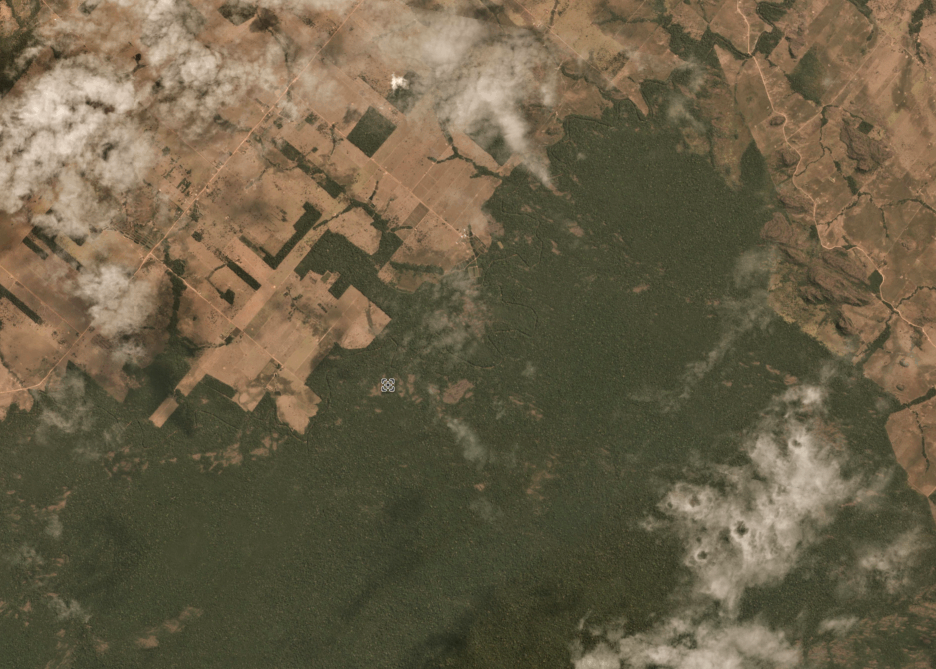- Rondônia is one of the most-deforested states in the Brazilian Amazon, with vast tracts cleared for agriculture.
- An investigation reveals that as deforestation of protected areas has risen in the state, so have allegations of attacks against the Indigenous communities.
- As budget cuts deplete resources aimed at protecting these communities, many are worried this violence stands to worsen in the months and years to come.
Deforestation is rife in the Brazilian state of Rondônia, which lies deep in the western Amazon rainforest. A new investigation by Greenpeace reveals that as deforestation of protected areas has risen in the state, so have allegations of attacks against the Indigenous communities that call its disappearing forests home. And as budget cuts deplete resources aimed at protecting these communities, many are worried this violence stands to worsen in the months and years to come.
Sitting on the western edge of Brazil’s infamous “arc of deforestation” – a huge swath of cleared land advancing in the wake of an ever-growing agricultural frontier – Rondônia is one of the most-deforested states in the Brazilian Amazon. In its middle, vast tracts of forest have been cleared for farmland, with remaining primary forests still hugging its borders where protected areas have afforded them relative safety.
The state’s protected areas cover about 40 percent of its area. But, for many, it appears their security is increasingly failing. According to researchers from the non-profit monitoring institute Imazon, Rondônia’s lack of available forest is prompting loggers to target trees in protected areas.

Imazon data indicate the state had three out of the five most deforested Amazon conservation units between 2012 and 2015. Data compiled by the University of Maryland and displayed on the forest monitoring platform Global Forest Watch show tree cover loss between 2001 and 2014 in Rondônia’s protected areas went up 22 percent between the first and last halves of that period.
These protected areas aren’t just meant to shelter forests. Indigenous communities also occupy many of them and are provided protections and rights through Brazil’s National Indigenous Foundation (Funai). But budget cuts appear to be compromising Funai’s ability to ensure these protections for communities in Rondônia and elsewhere in Brazil, according to findings by Greenpeace’s investigative news platform Unearthed.
Unearthed investigators traveled to Karipuna Indigenous Territory, where they interviewed members of the Karipuna tribe. During the interviews, tribe-members said loggers and land grabbers have increasingly targeted their forests since 2015.
“The invaders are marking their territory, they want to occupy and take our land,” tribal leader Adriano Karipuna told Unearthed investigators.
According to an annual report by Brazil’s Indigenous Missionary Council (CIMI), reported invasions of Indigenous territories went up from 54 in 2015 to 59 in 2016. Twelve of these occurred in Rondônia, which tied with Maranhao for the highest number recorded per state. CIMI representatives believe the numbers will be higher still for 2017 and 2018 if elections usher in a more conservative congress.

These invasions don’t just take trees – they can take human lives, as well. According to human rights watchdog Comissão Pastoral da Terra (CPT), 61 people died due to land and resource conflicts in the Amazon in 2016. At least 64 have been killed in 2017.
Budget cuts to environmental and indigenous agencies in Brazil, as well as new pro-farming legislation, are leaving many worried the situation stands to get worse. Karipuna’s support base from Funai has reportedly been abandoned, and Funai confirmed to Unearthed that its national budgets were cut by 44 percent in March 2017. In July, Brazil’s president Michel Temer signed a legal opinion to only officially recognize Indigenous territories occupied before 1988. While not legally binding, critics say it still has the power to incite more land conflicts.
When patrolling their land, the Karipuna told Unearthed investigators they bring guns to protect themselves as logging gangs in the region are known to be armed and violent. They report regularly finding areas of their territory that have been illegally deforested and burned.
Daniel Lobo, a federal prosecutor working on the Karipuna’s case told Unearthed that a majority of the timber taken from their territory ends up in sawmills in a nearby district before being exported abroad.
“In this region logging is more profitable than drug running and with much less risk,” Lobo said. He recalled a previous case where a logging gang reportedly made $6.15 million from illegally extracting timber from protected forests and Indigenous territories.
Globally, there is movement to empower local communities in the protection of their land. The UN’s REDD+ program is looking to increase inclusion of Indigenous groups in project planning and management, and nations recently agreed at COP23 to provide an official platform for Indigenous participation in climate talks.
But in Brazil, the reported acceleration of rural violence is making many worry that the country’s treatment of Indigenous communities may be going backwards.
“My greatest fear,” Adriano Karipuna told Unearthed, “is that we will be expelled from our land.”
FEEDBACK: Use this form to send a message to the editor of this post. If you want to post a public comment, you can do that at the bottom of the page.